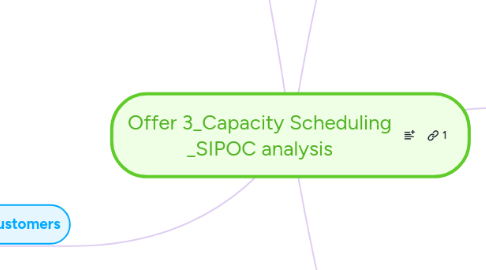
1. Suppliers
1.1. Who
1.1.1. Shipping
1.1.2. Maintenance
1.1.3. Mine Planning
1.1.4. Scheduling
1.1.5. Strategic Planning
1.1.5.1. LT Production Targets
1.1.5.2. Quartely forecasts
1.1.6. Marketing
1.1.6.1. Delivery, Shipping
1.1.7. Finance
1.1.7.1. Budgets / Financial constraints
2. Inputs
2.1. Data
2.1.1. Current Schedule
2.1.1.1. Inventory closing balances
2.1.1.2. Stockyards
2.1.1.3. Stockpile grade information
2.1.2. Sales/Ship Forecast
2.1.2.1. Product Split
2.1.2.2. Shipping Targets
2.1.2.2.1. Schedule - Laycans, ETA's, product requirements
2.2. Maintenance Plan
2.2.1. Mine & Port
2.2.1.1. Daily Actual Rates by Equipment (TPH)
2.2.1.2. Forecast Assumptions by Equipment (hrs / day)
2.2.1.3. Downtime Hours by Equipment
2.2.1.4. Maintenance Schedule
2.2.1.4.1. Shut durations and times4
2.3. Capacity/Capability (Business Drivers) assumptions for Mines, Rail and Port
2.3.1. Mine / OFR
2.3.1.1. Production rates by product
2.3.1.2. Processing reliability
2.3.1.3. Weekly availability / utilisation (OEE considerations re maintenance)
2.3.1.4. Mine Stockyard Min/Max targets and capacities
2.3.1.5. TLO rates
2.3.2. Rail
2.3.2.1. Travel Times (Empty & Loaded)
2.3.2.2. Queue times (Mine & Port terminals)
2.3.2.3. Loading / Unloading Times
2.3.2.4. Consist / rolling stock availability
2.3.2.5. Rolling stock reliability
2.3.2.6. Payload
2.3.2.6.1. Tonnes per car
2.3.2.7. Mainline availability (network)
2.3.3. Port (Inflow / Outflow)
2.3.3.1. Return Fines %
2.3.3.2. Dumping/Stacking - inloading rates
2.3.3.3. Dumping/Stacking - Inloading reliability
2.3.3.4. Port stockyard Min/Max targets, capacities and products
2.3.3.5. Stacking limitations
2.3.3.6. Outloading rates
2.3.3.7. Outloading reliability
2.3.4. New infrastructure / Commisioning
2.3.4.1. Commissioning dates
2.3.4.2. Ramp up rates
2.3.5. Quality Targets
2.3.5.1. Standard shipped quality targets per product
2.3.5.2. Boutique shipments
2.3.6. Shipping Trends
2.3.6.1. Vessel size info
2.3.6.2. Product per vessel strategy
2.3.6.3. Ship class strategy
2.3.6.4. Harbour capacity issues
2.3.6.5. Queue
2.3.7. Supply chain and operating tactics
3. Process
3.1. Decisions
3.1.1. Source material
3.1.1.1. Changes to Processing feed plans
3.1.1.2. Changes to Mine blend plan
3.1.2. Store material
3.1.2.1. Consider stockpile levels
3.1.2.2. Demurrage implications
3.1.2.3. Consider stockyard layout changes
3.1.3. Move material
3.1.3.1. Changes to Port blend plan
3.1.4. Manage Equipment
3.1.4.1. Changes to maintenance schedule
3.1.4.2. Throughput operating rates
3.1.5. Fulfillment (Demand)
3.1.5.1. Assess tonnage capability against committments
3.1.5.1.1. Changes to vessel product allocations
3.1.5.1.2. Changes to vessel timing's
3.1.5.1.3. Changes due to tides
3.1.6. Quality compliance
3.1.6.1. Assess grade capability against committments
3.1.7. Assess Trade-off's
3.1.7.1. Vertical - Supply chain
3.1.7.2. Horizontal - time
3.2. Objective
3.2.1. Determine System Constraints and risks based on operating philosophies
3.2.2. Optimise material flow from above decisions at mine(s), rail and port based on system constraints
3.2.3. Publish, Communicate and agree plan with stakeholders and Handover
4. Output
4.1. Generate Inventory Targets & Projections for Mine, Inloading, Outloading
4.2. Generate Throughput Targets, Operating rates and assumptions/rationale used for Mine, Rail and Port Capacity
4.2.1. Inloading (Train) per day
4.2.2. Outloading per day
4.2.2.1. Product aligned to vessels
4.3. Generate update for maintenance and scheduling tools
4.4. Conformance to Plan
4.5. Weekly (Period) supply chain tactics
5. Customers
5.1. Who & What (Problem statements and objectives)
5.1.1. Planning
5.1.1.1. 1. Ensure optimal equipment usage while taking into account scheduled maintenance
5.1.1.2. 2. Are we consuming all available supply?
5.1.1.3. 3. Robustness of the plan. How good is that plan?
5.1.1.3.1. How much daily firefighting is occuring in scheduling should gauge how robust and useful the plan is to the operational stakeholders
5.1.1.4. 4. Bottleneck identification over time
5.1.1.4.1. How does material variability change our bottleneck?
5.1.1.4.2. How does equipment variability change our bottleneck?
5.1.1.5. 5. Comparison / Evaluation of plans
5.1.1.5.1. Cost
5.1.1.5.2. Profitability
5.1.1.5.3. Meeting Longer term Mine Plans
5.1.1.5.4. Tonnes
5.1.1.5.5. Quality Plan
5.1.1.6. 6. Product Mix (qualities)
5.1.1.6.1. I need to communicate the quality, blending protocols and risks used in the planning horizon
5.1.1.6.2. Where to produce each product and how much of each product to make?
5.1.1.7. 7. How will my operational plan feed into the strategic and quarterly forecasts
5.1.2. Marketing
5.1.2.1. Are we fulfilling all contractual demand? If not, why not?
5.1.2.2. Products aligned to vessels? What is the product mix available
5.1.2.3. Are there any spot opportuninties given excess product inventory
5.1.2.4. Technical Marketing. What is the forecasted blend available?
5.1.3. Mine Schedulers
5.1.3.1. What quality/blend do you require and when
5.1.3.2. Is there unallocated supply in the Mine Stockyard that needs to be handled/stored i.e. Ultrafines)
5.1.4. Rail and port Schedulers
5.1.4.1. General
5.1.4.1.1. Inventory Targets
5.1.4.1.2. Operating Rate
5.1.4.1.3. Throughput targets
5.1.4.2. Inflow Capability
5.1.4.2.1. How much railing is required from the Mine(s) on a daily basis, a projection of the stocks for the Mine(s) is required
5.1.4.2.2. What is the target number of rakes/consists by product on a daily basis required by Car Dumper(s).
5.1.4.3. Outflow Capability
5.1.4.3.1. What is the daily shiploader targets by berth
5.1.4.3.2. What is the vessel line-up, on an hourly basis, based on demand
5.1.5. Operations Management
5.1.5.1. Utilisation - Where are we underutilising our fixed and mobile assets
5.1.5.2. Where are our bottlenecks across time for each time period
5.1.5.2.1. What is our SC bottleneck in scenario A? What is our SC bottleneck in scenario B?
5.1.5.3. What is trend in the plan in consideration of product and shipping cost
5.1.5.4. Cost impact (Typical Breakdown of costs per tonne)
5.1.5.4.1. 12% - Energy - Cost of fuel and Energy for mobile fleet and remote power
5.1.5.4.2. 53% - Labour and contractors
5.1.5.4.3. 14% - Freight and Distribution
5.1.5.4.4. 13% - Raw materials and consumables
5.1.5.4.5. 8% - Other
5.1.6. Maintenance
5.1.6.1. Long Term Scheduling (Short Term Planning)
5.1.6.1.1. Scheduler Identifies all interruptions to supply chain operations for the next ~8 weeks and consolidates information on an hourly basis for each equipment
5.1.6.2. Planning
5.1.6.2.1. Scheduler Identifies all interruptions to supply chain production in a ~X - 12/24 month time frame and either mitigates the interruption with alternative operating strategies or minimises the impact of the interruption by aligning it with other outages, generating the monthly hours downtime by equipment and operational area
